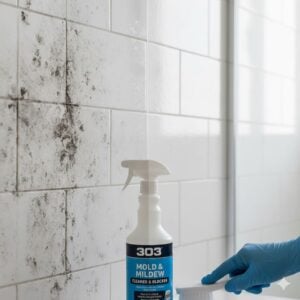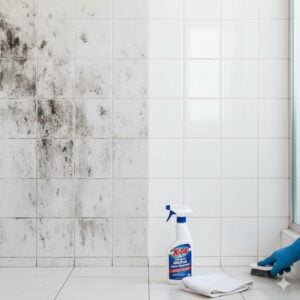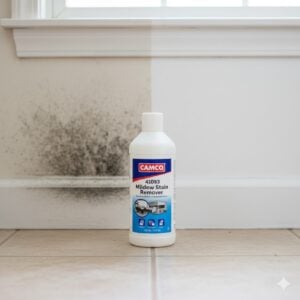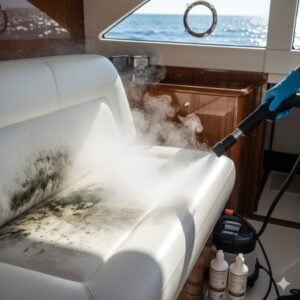When it comes to indoor contamination, people often confuse mold and mildew. Both are types of fungi that thrive in damp, humid environments and spread through airborne spores. However, the way they look, grow, and affect health can be very different. For homeowners in humid regions like the UAE, knowing the difference can help determine the right kind of testing and treatment. This article explores six major differences between mold and mildew, focusing especially on mold vs mildew test methods, how to identify them, and how professional inspections like those by Bio-On UAE ensure accurate diagnosis and safe remediation.
Table of Contents
Toggle1. Appearance: How Mold and Mildew Look Under Inspection
The first and most visible difference between mold and mildew is their appearance. Mildew usually looks like a gray or white powdery layer that sits flat on surfaces — similar to dust or chalk. It spreads across moist organic materials such as paper, cloth, and bathroom tiles.
Mold, however, is far more aggressive. It grows three-dimensionally, forming fuzzy, slimy, or even velvety textures in colors ranging from black and green to brown or yellow. Mold colonies appear patchy and can penetrate deeply into porous surfaces like drywall, wood, or carpet padding. Over time, mold causes material decay, warping, or softening.
In a mold vs mildew test, experts typically perform a visual inspection using magnified lenses or borescopes. Mildew’s surface-level presence is easy to wipe away, while mold resists removal and reappears quickly if not treated from the root. Surface tape samples or swab tests help confirm whether the material’s discoloration is superficial mildew or deep fungal colonization.
2. Growth Patterns and Environmental Conditions
Both mold and mildew thrive in damp areas, but their growth conditions differ significantly. Mildew prefers mild, humid environments such as bathrooms, window sills, and damp fabrics. It spreads in circular patches that remain near the surface and can often be controlled with regular ventilation or mild cleaning agents.
Mold, on the other hand, flourishes in persistently moist or water-damaged areas. It can grow behind walls, under carpets, and inside HVAC ducts — places that remain warm and poorly ventilated. Mold growth begins within 24 to 48 hours after exposure to water and can spread rapidly across large areas. Unlike mildew, it releases mycotoxins and produces a strong earthy odor, signaling contamination.
Professionals use humidity meters and infrared thermal cameras during mold inspections to detect hidden moisture sources. These tools help distinguish mildew-prone condensation issues from serious mold infestations requiring remediation.
3. Health Impact: Mold Is Far More Dangerous
While mildew can trigger mild allergic reactions, mold poses more serious health threats. The spores released by toxic molds such as Aspergillus or Stachybotrys chartarum (commonly known as black mold) can cause respiratory issues, eye irritation, fatigue, and long-term immune complications. Prolonged exposure may lead to chronic sinus infections, skin rashes, or even neurological symptoms in sensitive individuals.
Mildew exposure typically causes mild sneezing or throat irritation, often subsiding once the area is cleaned. Mold exposure, however, can persist and worsen because spores travel through air circulation systems, contaminating other rooms. For this reason, mold vs mildew test results have direct implications for occupant safety. Accurate mold testing identifies not only visible colonies but also airborne spore concentration levels.
Bio-On UAE technicians conduct air quality testing using spore traps and lab culture analysis. The collected samples reveal whether the air contains allergenic or toxigenic species, allowing targeted treatment rather than guesswork.
4. Testing Methods: Mold vs Mildew Test Procedures
Testing methods differ based on the suspected fungus type. Here’s how experts typically compare mold and mildew testing:
Visual and Surface Testing
Visual assessment is the first step. Inspectors evaluate discoloration, growth texture, and spread pattern. For mildew, simple surface swabs and microscopy confirm the presence of common genera such as Erysiphales. For mold, more comprehensive sampling is necessary since colonies often grow beneath the surface.
Air Sampling and Laboratory Analysis
Air sampling captures airborne spores to determine the type and density of fungal contamination. Mold air tests identify spores invisible to the naked eye, which are crucial for diagnosing hidden infestations. Mildew rarely requires air testing because it remains superficial and does not produce significant airborne spores.
Moisture Mapping and pH Measurement
Another essential part of mold testing involves mapping humidity and measuring pH levels of affected materials. Mold thrives in areas with pH between 3 and 7, while mildew grows in slightly more neutral environments. These subtle differences guide professionals toward accurate remediation plans.
Lab Differentiation
In the lab, mildew spores appear oval and smooth under the microscope, while mold spores are irregular, larger, and sometimes pigmented. Molecular-level analysis using PCR (Polymerase Chain Reaction) testing can confirm species, identifying whether the growth is hazardous or benign.
5. Cleaning and Removal Methods: Why Mold Requires More Than Surface Wiping
Mildew removal is relatively straightforward. Since it remains on the surface, household cleaners or diluted vinegar solutions often work effectively. A simple scrub with a mild detergent and proper drying can prevent regrowth. Regular cleaning and improved ventilation usually keep mildew at bay.
Mold remediation, however, is a complex process. Once mold penetrates porous materials, surface cleaning is insufficient. Mold removal involves containment, air filtration, material extraction, and anti-fungal treatment. Professionals use HEPA filters to capture airborne spores during the process to prevent cross-contamination. In cases of severe infestation, sections of drywall or insulation may need replacement.
DIY mold removal is risky because improper handling can release millions of spores into the air. Inhaling these spores can cause respiratory distress, especially for children or the elderly. Moreover, DIY methods often ignore moisture sources, allowing regrowth within days. Professional cleaning ensures deep disinfection and long-term prevention through dehumidification and sealing techniques.
6. Cost Difference: Professional Testing vs DIY Attempts
At first glance, DIY testing kits seem cheaper — most cost between AED 70 and AED 150. These kits include petri dishes or tape lifts to collect surface samples, but they rarely provide species-level accuracy or identify airborne spores. They’re useful for preliminary screening but can’t replace certified laboratory analysis.
Professional mold vs mildew test packages in the UAE start around AED 1000. This typically includes surface sampling, air testing, humidity measurement, and full laboratory reporting. Bio-On UAE’s testing team performs multi-step assessments, offering detailed results that include fungal type, spore count, and contamination severity.
Considering the potential health risks and property damage mold causes, professional testing is a worthwhile investment. If detected early, remediation costs remain minimal. Ignoring the issue can lead to extensive structural damage, costing thousands more in restoration.
Summary Table: Mold vs Mildew Test Differences
| Category | Mold | Mildew |
|---|---|---|
| Appearance | Fuzzy, slimy texture; black, green, or brown color | Powdery, flat surface; white or gray color |
| Growth Depth | Penetrates deep into materials like wood and drywall | Stays on surface; easy to wipe off |
| Health Impact | Severe allergic and toxic effects possible | Mild irritation; rarely toxic |
| Testing Methods | Air sampling, PCR, pH, and moisture testing | Visual or surface swab test |
| Cleaning Requirements | Professional remediation and containment needed | Surface cleaning with mild detergent |
| Average Test Cost (UAE) | ~AED 1000 per test | ~AED 100–150 for home kit |
DIY Mold and Mildew Testing: When It Works and When It Doesn’t
DIY kits are useful for quick checks in small spaces, but they cannot determine contamination levels accurately. They’re suitable for mild surface growths in bathrooms or window sills but unreliable for detecting toxic molds hidden behind walls or HVAC systems. The biggest drawback is interpretation — petri dish results show fungal growth but can’t identify whether it’s dangerous.
Professional inspectors, like Bio-On UAE’s specialists, don’t just test; they interpret the results and advise the next steps. This distinction matters when dealing with potential black mold or when planning renovations in affected properties.
Preventing Mold and Mildew Growth
- Maintain indoor humidity between 40–55% using dehumidifiers.
- Fix leaks immediately — even small drips create ideal conditions for spores.
- Ventilate kitchens and bathrooms with exhaust fans.
- Clean air conditioner filters regularly to reduce condensation buildup.
- Use anti-fungal coatings or sealants in moisture-prone rooms.
Routine inspections every 6–12 months can prevent serious contamination. Bio-On UAE offers scheduled monitoring for properties that previously faced mold issues, ensuring early detection and quick remediation if spores return.
Conclusion
Mold and mildew may look similar, but they differ significantly in structure, impact, and treatment. Mildew is a surface-level nuisance that regular cleaning can remove, while mold is an invasive, toxic threat that requires professional testing and remediation. Understanding the six main differences — appearance, environment, health effects, testing method, cleaning requirements, and cost — helps homeowners act wisely and prevent long-term damage. For accurate mold vs mildew test results and safe remediation, Bio-On UAE remains a trusted expert in the field. With laboratory-backed analysis, advanced moisture detection, and 24/7 service, Bio-On ensures your home stays clean, healthy, and mold-free year-round.













